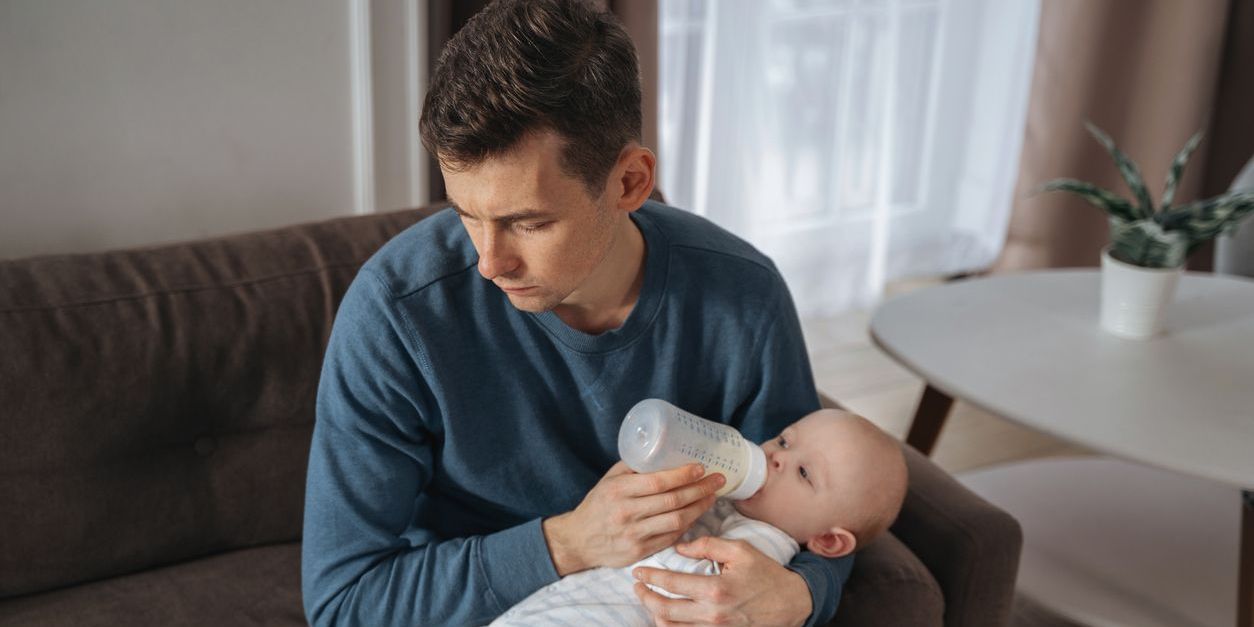Summary: Yes, paternal perinatal depression is a real thing. It resembles maternal perinatal or postpartum depression but appears in fathers rather than mothers.
Key Points:
- Fathers can develop a depressive disorder associated with the birth of a child
- Paternal perinatal depression may appear during partner pregnancy or after delivery
- Symptoms can affect child development and partner relationships
- Standard treatment for depression can be effective in reducing symptoms and achieving remission
What is Paternal Perinatal Depression?
Most of us have heard of perinatal depression or postpartum depression, which are types of depression that appears in mothers during pregnancy and in the months following pregnancy, respectively. Primary symptoms include sadness, anxiety, fatigue, problems bonding with newborn, and doubt about parenting ability. Perinatal and postpartum depression can be severe, and we encourage new mothers who experience depressive symptoms to seek professional support.
The topic of this article is something many people have never heard about – a depressive disorder, related to a new child, that develops in fathers.
Evidence shows about 1 in 10 fathers develop paternal perinatal depression.
Here’s an official definition of the disorder from the patient support article “What Is Paternal Perinatal Depression?”: published by the Journal of the American Medical Association (JAMA) in 2025:
“[Paternal perinatal depression is] when fathers experience depressive symptoms during their partner’s pregnancy and/or during the first year of their infant’s life.”
Any new father or expecting father can develop this depressive disorder, which we’ll refer to as PaPD throughout the rest of this article. There are several factors that increase likelihood of developing PaPD, called risk factors:
Risk Factors for PaPD
- Maternal depression
- Personal history of depression
- Family history of depression
- Financial stress
- Medical problems for the mother during pregnancy
- Medical problems for the fetus during pregnancy
- Difficulty adjusting to the idea of fatherhood
- Difficulty adjusting to actual fatherhood
- Sleep deprivation
- Relationship difficulty/stress
In addition to common risk factors, mental health experts identify the following common signs and symptoms:
Signs and Symptoms of PaPD
- Persistent feelings of sadness
- Persistent feelings of anxiety
- Difficulty concentrating
- Loss of interest in favorite activities/hobbies
- Difficulty sleeping
- Chronic fatigue
- Irritability
- Anger
- Staying longer at work
- Increased screen time
- Increased alcohol/drug use
Those are the basic facts about PaPD that are essential for families to understand. While it may seem obvious to some people that fathers can develop depression associated with a new child, it may not be so obvious for others. In either case, paternal perinatal depression is a real thing and can have a direct impact on family life and child development.
The Consequences of Paternal Perinatal Depression
If a father shows the signs and symptoms above – and risk factors are present – it’s important to address the issue. The consequences for the family can be significant, and may include:
- Disrupted/decreased bonding between father and child
- Increased relationship stress/conflict in home
- Increased postpartum depression in partner
- Paternal resentment of child
- Negative parenting style, including corporal punishment
- Decreased positive engagement with/warmth toward child
- Decreased adherence to safe parenting practices
- Elevated risk of emotional, behavioral, and conduct problems in children
Given the reality of the disorder, the prevalence – 1 in every 10 fathers – and the severity of the consequences, early identification and diagnosis for PaPD is essential. Experts on both maternal and paternal peripartum/postpartum depression indicate there are two places/situations that are ideal for screening for PaPD:
- Primary care settings. PCPs should know a patient is an expecting or new father and should administer evidence-based screenings for presence of symptoms.
- Specialty mental health settings. Mental health providers should also know a patient is an expecting or new father and should administer evidence-based screenings for presence of symptoms.
- Evidence-based screening tools include:
- Edinburgh Postpartum Depression Scale (EPDS)
- Patient Health Questionnaire (PHQ-9)
- Gotland Male Depression Scale (GMDS)
Screening for paternal perinatal depression should occur as soon as any concerning symptoms appear, including before birth and within the first three to six months after delivery.
We’ll discuss treatment for PaPD in a moment. First, we’ll review the results of the latest research on the impact of PaPD on children.
What Impact Does Paternal Perinatal Depression Have on Child Development?
Previous research, cited above, identifies increased risk of adverse childhood experiences (ACEs) and negative externalizing behaviors but not internalizing disorders. A new study called “Paternal Perinatal Depression, Anxiety, and Stress and Child Development: A Systematic Review and Meta-Analysis” asks this general question about the impact of PaPD on overall childhood development, as opposed to mental health or behavioral disorders:
“Is paternal perinatal mental distress (depression, anxiety, and stress) adversely associated with offspring development from birth to 18 years of age?”
To arrive at an answer, the research team examined data from 84 studies that measured the effect of PaPD on children from birth to age 18. Researchers analyzed records of men with PaPD and instances of problems in the following areas
- Global development: overall developmental milestones
- Social-emotional development: the ability to interact with and relate to others
- Adaptive development: the ability to carry out basic functional tasks of daily life
- Cognitive development: the ability to think, process stimuli, and make decisions
- Language development: the ability to learn and use words for communication
- Physical development: basic physical milestones such as height and weight
- Motor development: growth of bones, muscles, and nervous system that allows a child to move through, touch, and interact with their surroundings
They found that paternal perinatal mental distress was associated with impaired/decreased development in some, but not all of the areas examined. PaPD had a negative impact on the following outcomes:
- Overall development (based on cumulative development scores)
- Social-emotional development
- Cognitive development
- Language development/acquisition
- Physical development
The strongest impacts were associated with distress and depression among fathers after birth rather than before, with researchers concluding that paternal mental health may have a “more direct influence” during infancy rather than during pregnancy/gestation.
Now let’s circle back, and discuss the best treatment approaches for PaPD.
Paternal Perinatal Depression Diagnosis: New, Targeted Screening, Tailored Intervention, Comprehensive Approach
Dr. Craig Garfield of the Lurie Children’s Hospital of Chicago, author of an article we cite above, “What is Paternal Perinatal Depression?,” developed a new screening tool called PRAMS (Pregnancy Risk Assessment Monitoring System) for Dads. In an interview about the results of the meta-analysis we also cite above, Dr. Garfield explains why we need this new depression screening tool:
“Birth of a child can be highly stressful for both parents. In the U.S., new mothers have been screened routinely for postpartum depression since 2010. We need to apply the same strategy to new fathers, since more and more studies like this one show that paternal mental health impacts child development and the wellbeing of an entire family.”
Like all mental health disorders, early diagnosis and treatment of PaPD is associated with better outcomes. Where PaPD is concerned, this is important not only for the father, but – as Dr. Garfield points out – for the health of the child and the mother, and the long-term wellbeing of the entire family.
If you’re a new dad experiencing depressive symptoms, you may think you don’t need help, or that you should be able to handle it yourself. You may be right. However, we encourage you to read the following quotes from new dads, which may make you feel less alone.
Here’s how many new fathers with PaPD feel before treatment;
“Nobody tells you how hard it really is.”
“I was so ready to be a dad, but all I can think about is how miserable I am.”
And here’s what two said after asking for and receiving help:
“Men are expected to be big and strong and stoic, to take care of everything, to be a tough guy. It was hard to acknowledge that I needed help.”
“I did not know anything about fathers getting postpartum depression. By the time I realized I had depression, our family had nearly broken apart.”
In addition, fathers with depression or anxiety use the following words to describe how they feel in their new role: invisible, overwhelmed, resentful, trapped, unnecessary, helpless, forgotten, and inadequate. That’s clearly not an ideal place to be when caring for an infant.
Let’s take a look at the kind of support that can help new dads with depression.
Paternal Perinatal Depression Treatment: Tailored Intervention, Comprehensive Approach
At the most basic level, treatment for paternal perinatal depression includes the same components treatment for depression and postpartum depression: a combination of psychotherapy, medication, social support, and lifestyle adjustments.
Psychotherapeutic techniques include:
- Cognitive behavioral therapy (CBT)
- Dialectical behavior therapy (DBT)
Medication may include:
- Antidepressants
- Anxiolytics
Social support systems that help include:
- Family and friends
- Online support groups
- In-person support groups
Lifestyle adjustments:
- Healthy eating
- Reduced alcohol, caffeine, and sugar
- Daily exercise and activity
- Stress management, i.e. yoga, mindfulness
We’ll take a moment to address social support for new fathers. The first thing to know is that support for new fathers exists. In fact, there’s a wide range of support and training programs to choose from.
For New Fathers: Depression Resources, Parenting Resources
- General support: Postpartum Support International (PSI): Help for Dads
- Specific paternal depression support: SadDaddy | A Website for Postpartum Men
- Parenting Classes for Dads: Basic Training for New Dads
- Boot Camps for Dads: Find By State — Boot Camp for New Dads
- For new dads 17-24: The Dovetail Project
In closing, we’ll answer the question we pose in the title again. Yes, paternal perinatal depression is a real thing, appears in about 10 percent of new fathers, and can have severe, negative consequences for everyone involved: the father, the mother, and the child. However, effective, evidence-based support and treatment is available, and there are a wide variety of online and in-person support groups that can help.
If you’re a new father and feel alone and confused, please understand that you’re not alone, and there are expert professionals – like us here at Crownview Medical – who can offer high-quality, evidence-based treatment and support for all types of depressive disorders, including paternal perinatal depression.
Angus Whyte has an extensive background in neuroscience, behavioral health, adolescent development, and mindfulness, including lab work in behavioral neurobiology and a decade of writing articles on mental health and mental health treatment. In addition, Angus brings twenty years of experience as a yoga teacher and experiential educator to his work for Crownview. He’s an expert at synthesizing complex concepts into accessible content that helps patients, providers, and families understand the nuances of mental health treatment, with the ultimate goal of improving outcomes and quality of life for all stakeholders.


 Myriame Nicolas, PMHNP-BC
Myriame Nicolas, PMHNP-BC Charlie Perez, PMHNP-BC
Charlie Perez, PMHNP-BC Kelvin Poon, MSN, PMHNP-BC
Kelvin Poon, MSN, PMHNP-BC


 Apneet Mann, FNP-C
Apneet Mann, FNP-C Kimberly Umansky, FNP-C
Kimberly Umansky, FNP-C Joanne Talbot Miller, M.A., LMFT
Joanne Talbot Miller, M.A., LMFT Rachael Hueftle, NP
Rachael Hueftle, NP J. Heather Fitzpatrick, LCSW
J. Heather Fitzpatrick, LCSW Agata Nowakowska
Agata Nowakowska Brianna Meacham
Brianna Meacham Maha Moses, PhD
Maha Moses, PhD Rebecca McKnight, PsyD
Rebecca McKnight, PsyD Tiffany Holm N.P.
Tiffany Holm N.P. Dede Echitey, PMHNP-BC
Dede Echitey, PMHNP-BC


